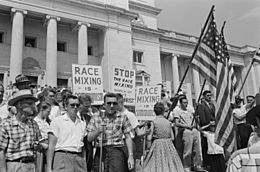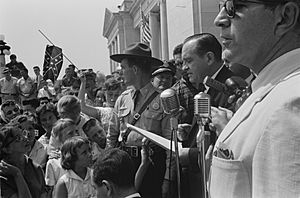Women's Emergency Committee to Open Our Schools facts for kids

Little Rock, 1959. Rally at state capitol, protesting the integration of Central High School. Protesters carry US flags and signs reading "Race Mixing is Communism" and "Stop the Race Mixing March of the Anti-Christ". Photograph by John T. Bledsoe.
|
|
| Formation | 1958 |
|---|---|
| Type | Civil rights |
| Headquarters | Little Rock, Arkansas, US |
|
Membership
|
1,400 |
|
Official language
|
English |
|
President
|
Adolphine Fletcher Terry |
|
Key people
|
Vivion Brewer, Velma Powell |
The Women's Emergency Committee to Open Our Schools (WEC) was a group started by women in Little Rock, Arkansas, in 1958. They formed during a difficult time known as the Little Rock Crisis. The WEC wanted to see public schools in Little Rock open again and allow students of all races to attend together. This group became a big challenge to Governor Orval Faubus, who was trying to stop schools from integrating. The women also spoke out, asking for a special election to remove people from the school board who wanted to keep schools separate.
Contents
Why the WEC Was Formed
Schools Close in Little Rock
In 1954, the U.S. Supreme Court made a big decision in a case called Brown v. Board of Education. This ruling said that having separate schools for different races was against the law. After this, a group called the NAACP helped nine talented Black students, known as the Little Rock Nine, to attend Little Rock Central High School. This school had only been for white students before.
On September 4, 1957, there were protests at the school. Arkansas Governor Orval Faubus sent the Arkansas National Guard to stop the Black students from entering. This went against the Supreme Court's decision. The situation got worse when Governor Faubus ordered all public high schools in Little Rock to close. He did this rather than allow the nine students to attend with white students.
Starting the WEC
Because of this crisis, three women named Adolphine Terry, Vivion Brewer, and Velma Powell decided to create the Women's Emergency Committee to Open Our Schools (WEC). Adolphine Terry was 75 years old and well-known in her community. Vivion Brewer had helped start Little Rock's orchestra and library.
Terry held the first meeting at her home on September 16, 1958. Fifty-eight women attended. By May of the next year, the group had grown to 1,400 members. Most of these women were white, wealthy, and educated. Their wealth helped protect them from financial problems that other people might face for speaking out. Even so, the women faced strong opposition. They received mean phone calls, insults, and threatening letters.
The WEC's founders wanted the group to include people of all races and fully integrate schools. However, the group decided to focus on simply re-opening the schools. They kept their membership mostly white to gain more public support.
What the WEC Did
Working for School Elections
The WEC worked hard to encourage voters in Little Rock to vote for integration. They believed this was the way to end the school crisis. The group organized phone calls and car rides to help people get to the polls. However, the first election did not go the way the WEC hoped.
The WEC then put pressure on white men in the community. They talked to business leaders and later published a report called The Little Rock Report. This report showed how much the school crisis was hurting the city's economy. The organization also had a committee that encouraged women to talk to male community leaders and businessmen. They wanted these men to speak out more against segregation.
The WEC was the first white organization in Little Rock to speak out against segregation. They even had some of their members appear on a short TV panel. Later, they organized a TV panel with local ministers.
School Board Changes
After five school board members resigned, the WEC started a campaign to find new leaders. They wanted moderate and fair business leaders to run for the open spots. The WEC helped elect new members, which led to an evenly divided school board. Their role in this campaign was kept secret to avoid negative attention for the candidates. This split school board later led to another election to remove some members.
Showing Economic Problems
In January 1958, the WEC started putting advertisements in newspapers. These ads showed how the school crisis was hurting Little Rock's economy. In 1959, the Chamber of Commerce asked its members what they thought. Seventy-one percent said they supported "a small plan of integration" to end the crisis.
People who supported segregation then demanded to see the WEC's list of members. They used a 1957 law that required groups to list their members and financial supporters. To protect its members, the WEC never made a formal list. They kept their mailing list hidden in a different home each night. When the city only received financial documents, WEC leaders were threatened with arrest. But none of the members were ever arrested.

Recalling School Board Members
During this time, WEC members also talked to lawmakers in the Arkansas General Assembly every day. In February 1959, a state representative tried to pass a bill. This bill would let Governor Faubus appoint three temporary members to the Little Rock School Board. WEC members spoke to the representative about the bill. He told them to "please shut up" and admitted the law was "a little on the dictator side." The bill was eventually defeated.
In May 1959, the Little Rock School Board voted not to renew the contracts of 45 teachers. These teachers were thought to support federal efforts to integrate schools. This action pushed the WEC to start a door-to-door effort to remove the remaining school board members. They wrote articles and helped people register to vote.
Many groups spoke out against the board's actions. These included the League of Women Voters and the Chamber of Commerce. A new group called "Stop This Outrageous Purge" (STOP) was also formed. Even though STOP tried to avoid being publicly linked with the WEC, many of STOP's leaders were married to WEC members. Later, many people gave credit to the WEC for STOP's success. The WEC became the main workforce for STOP's plans. They collected 9,000 signatures to remove the segregationist school board members. They also handed out flyers and helped voters, using what they learned from past campaigns.
This campaign led to the removal of the school board members who supported segregation. Three new, more moderate members were elected. On August 12, 1959, Little Rock's public high schools re-opened. Black students attended every school.
What Happened Next
Members of the WEC continued to work on education issues. They also supported campaigns for moderate leaders in the South. They even advised similar groups in cities like Atlanta and New Orleans. However, after achieving their main goals, the group decided to officially close down in 1963. In 2015, the WEC was honored as one of the first groups inducted into the Arkansas Women's Hall of Fame.

